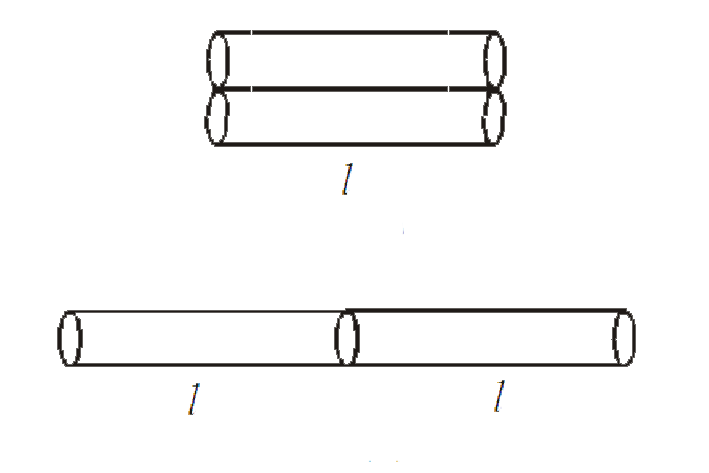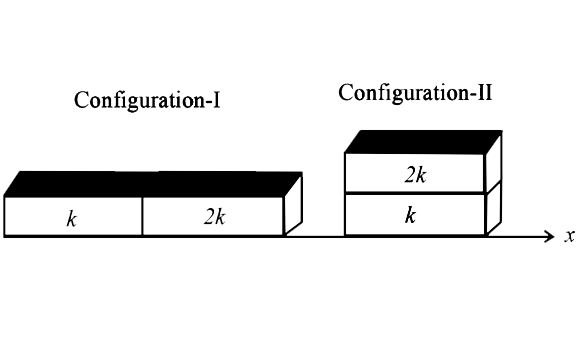Two rods of the same length and material transfer a given amount of heat in 12 seconds when they are joined end to end. But when they are joined lengthwise, they will transfer the same amount of heat, in the same conduction, in :
24 s
10 s
15 s
48 s
The correct Answer is:D
To solve the problem, we need to analyze how heat conduction works in both configurations of the rods (end-to-end and lengthwise).
1. Understanding Heat Transfer in Rods:
The rate of heat transfer (Q) through a rod is given by the formula:
Qt=k⋅A⋅ΔTL
where:
- Q = amount of heat transferred
- t = time taken for heat transfer
- k = thermal conductivity of the material
- A = cross-sectional area of the rod
- ΔT = temperature difference across the rod
- L = length of the rod
2. Configuration 1: End-to-End Connection:
When the two rods are connected end-to-end, the total length becomes 2L and the area remains A. The time taken to transfer heat is given as t=12 seconds.
t1=2LA⋅(constant factors)
Thus, we can express the time taken as:
t1=k⋅2LA⋅ΔT
Since t1=12 seconds, we have:
12=k⋅2LA⋅ΔT
3. Configuration 2: Lengthwise Connection:
When the rods are connected lengthwise, the effective length remains L for each rod, but the area is halved (assuming they have the same cross-sectional area). Therefore, the new area A′=A2.
The time taken in this configuration can be expressed as:
t2=LA/2⋅(constant factors)
This simplifies to:
t2=k⋅L(A/2)⋅ΔT=k⋅2LA⋅ΔT
4. Relating the Two Configurations:
From the first configuration, we have:
12=k⋅2LA⋅ΔT
From the second configuration, we have:
t2=k⋅2LA⋅ΔT
Since both expressions are equal, we can substitute:
t2=4⋅t1
Therefore:
t2=4⋅12=48 seconds
Final Answer:
The time taken to transfer the same amount of heat when the rods are joined lengthwise is 48 seconds.
The rate of heat transfer (Q) through a rod is given by the formula:
Qt=k⋅A⋅ΔTL
where:
- Q = amount of heat transferred
- t = time taken for heat transfer
- k = thermal conductivity of the material
- A = cross-sectional area of the rod
- ΔT = temperature difference across the rod
- L = length of the rod
When the two rods are connected end-to-end, the total length becomes 2L and the area remains A. The time taken to transfer heat is given as t=12 seconds.
t1=2LA⋅(constant factors)
Thus, we can express the time taken as:
t1=k⋅2LA⋅ΔT
Since t1=12 seconds, we have:
12=k⋅2LA⋅ΔT
When the rods are connected lengthwise, the effective length remains L for each rod, but the area is halved (assuming they have the same cross-sectional area). Therefore, the new area A′=A2.
The time taken in this configuration can be expressed as:
t2=LA/2⋅(constant factors)
This simplifies to:
t2=k⋅L(A/2)⋅ΔT=k⋅2LA⋅ΔT
From the first configuration, we have:
12=k⋅2LA⋅ΔT
From the second configuration, we have:
t2=k⋅2LA⋅ΔT
Since both expressions are equal, we can substitute:
t2=4⋅t1
Therefore:
t2=4⋅12=48 seconds
The time taken to transfer the same amount of heat when the rods are joined lengthwise is 48 seconds.
Topper's Solved these Questions
- BOOK - PHYSICS GALAXY - ASHISH ARORACHAPTER - HEAT TRANSFER EXERCISE - Advance MCQs with One or More Option Correct20videos
HEAT TRANSFER
- BOOK - PHYSICS GALAXY - ASHISH ARORACHAPTER - HEAT TRANSFER EXERCISE - Unsolved Numerical Problems for Preparation of NSEP,INPhO&IPhO66videos
HEAT TRANSFER
- BOOK - PHYSICS GALAXY - ASHISH ARORACHAPTER - HEAT TRANSFER EXERCISE - Conceptual MCQs Single Option Correct24videos
HEAT TRANSFER
- BOOK - PHYSICS GALAXY - ASHISH ARORACHAPTER - HEAT AND THERMAL EXPANSIONEXERCISE - UNSOLVED NUMRICAL PROBLEMS FOR PREPARATION OF NSEP, INPhO & IPhO82videos
HEAT AND THERMAL EXPANSION
- BOOK - PHYSICS GALAXY - ASHISH ARORACHAPTER - Kinetic Theory of Gases and Gas LawsEXERCISE - Unsolved Numerical Problems for Preparation of NSEP, INPhO & IPhO64videos
Kinetic Theory of Gases and Gas Laws
Similar Questions
Two rods of same length and transfer a given amount of heat 12 second, when they are joined as shown in figure (i). But when they are joined as shwon in figure (ii), then they will transfer same heat in same conditions in
 View Solution
View SolutionTwo rods made of same material having same length and diameter are joined in series. The thermal power dissipated through then is 2W.If they are joined in parallel, the thermal power dissipated under the same conditions on the two ends of the rods, will be :
View Solution
Knowledge Check
- Question 1 - Select One
Two rods of same length and material transfer given amount of heat in 12 s, when they are joined end to end. When they are joined parallelly then they will transfer same amount of heat in same conditions in
A1.5sB3sC24sD48s - Question 2 - Select One
Two rods are of same material and having same length and area. If heat ΔQ flows through them for 12 min when they are joined side by side. If now both the rods are joined in parallel, then the same amount of heat ΔQ will flow in
A24 minB3 minC12 minD6 min - Question 3 - Select One
Two rectangular blocks, having identical dimensions, an be arranged either in configuration-I or in configuration-II as shown in the figure. One of the blocks has thermal conductivity k and the other 2k. The temperature difference between the ends along the x-axis is the same in both the configurations. It takes 9s to transport a certain amount of heat from the hot end to the cold end in the configuration-I. The time to transport the same amount of heat in the configuration-II is
 A2.0sB4.5sC3.0sD6.0s
A2.0sB4.5sC3.0sD6.0s
The lengths and radii of two rods made of same material are in the ratios 1 : 2 and 2 : 3 respectively. If the temperature difference between the ends for the two rods be the same, then in the steady state, the amount of heat flowing per second through them will be in the ratio
View SolutionThe lengths and radii of two rods made of same material are in the ratios 1 : 2 and 2 : 3 respectively. If the temperature difference between the ends for the two rods be the same, then in the steady state, the amount of heat flowing per second through them will be in the ratio
View SolutionTwo rods of the same length and areas of cross-section A1 and A2 have their ends at the same temperature. K1 and K2 are the thermal conductivities of the two rods. The rate of flow of heat is same in both the rods if-
View SolutionTwo rods of the same length and diameter having thermal conductivities K1 and K2 are joined in parallel. The equivalent thermal conductivity of combination is
View SolutionTwo rods of the same length and diameter having thermal conductivities K1 and K2 are joined in parallel. The equivalent thermal conductivity of combination is
View Solution

